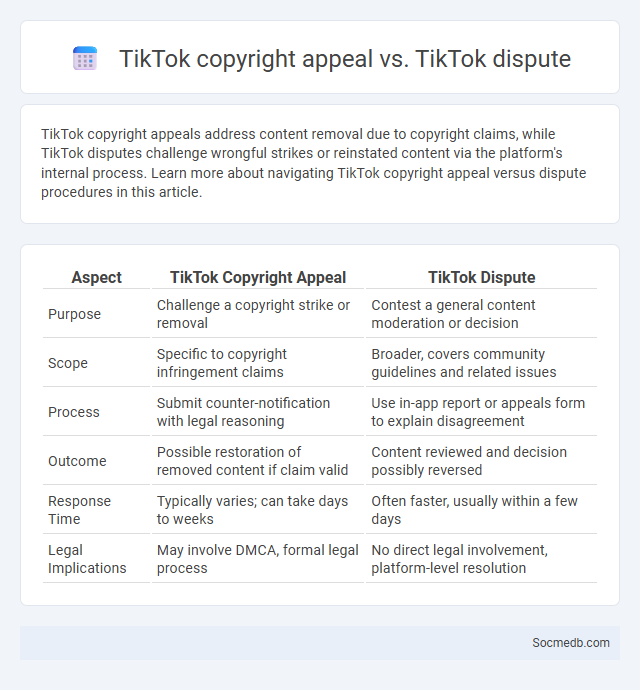
Photo illustration: TikTok copyright appeal vs TikTok dispute
TikTok copyright appeals address content removal due to copyright claims, while TikTok disputes challenge wrongful strikes or reinstated content via the platform's internal process. Learn more about navigating TikTok copyright appeal versus dispute procedures in this article.
Table of Comparison
| Aspect | TikTok Copyright Appeal | TikTok Dispute |
|---|---|---|
| Purpose | Challenge a copyright strike or removal | Contest a general content moderation or decision |
| Scope | Specific to copyright infringement claims | Broader, covers community guidelines and related issues |
| Process | Submit counter-notification with legal reasoning | Use in-app report or appeals form to explain disagreement |
| Outcome | Possible restoration of removed content if claim valid | Content reviewed and decision possibly reversed |
| Response Time | Typically varies; can take days to weeks | Often faster, usually within a few days |
| Legal Implications | May involve DMCA, formal legal process | No direct legal involvement, platform-level resolution |
Understanding TikTok Copyright Systems
TikTok's copyright system utilizes automated content recognition tools, such as Audible Magic, to detect unauthorized use of copyrighted audio and video materials. Creators must navigate TikTok's digital rights management policies, which include Content ID matches and dispute options to protect intellectual property. Understanding TikTok's copyright enforcement ensures compliance, helps avoid content removal, and supports the fair use of original multimedia content.
What Is a TikTok Copyright Appeal?
A TikTok copyright appeal is a formal request submitted by users to challenge a copyright claim made against their uploaded content. This appeal process allows creators to dispute allegations of copyright infringement, providing evidence or clarification to support their case and restore the removed or restricted video. Successful appeals enable content to be reinstated on the platform, protecting creators' rights and promoting fair use principles in social media.
How Does the TikTok Dispute Process Work?
TikTok's dispute process begins when a user receives a content removal notice or copyright claim, prompting them to submit a formal counter-notification through the platform's reporting system. The counter-notification must include specific details such as the user's contact information, a description of the disputed content, and a statement under penalty of perjury asserting the user's good faith belief that the content was wrongly removed. After submission, TikTok reviews the claim and may reinstate the content unless the original complainant files a legal action within a set timeframe, typically 10 to 14 business days.
Defining Copyright Infringement on TikTok
Copyright infringement on TikTok occurs when users post, share, or remix content without obtaining permission from the original creator or copyright holder, violating intellectual property rights. TikTok's automated detection system and user reporting mechanisms help identify unauthorized use of music, videos, and other copyrighted materials. Protecting Your content and respecting others' copyrights ensures compliance with TikTok's Community Guidelines and avoids legal consequences.
Key Differences: Copyright Appeal vs Dispute on TikTok
TikTok's copyright appeal process allows you to challenge a content removal by proving your rights or fair use, while a copyright dispute involves both parties negotiating outside the platform to resolve the ownership issue. Appeals focus on reversing TikTok's enforcement decisions, whereas disputes often require legal intervention or direct agreements between the copyright holder and the content creator. Understanding these differences ensures your content remains compliant and protected on TikTok.
Step-by-Step: Filing a TikTok Copyright Appeal
Filing a TikTok copyright appeal involves first reviewing the specific claim to understand the alleged violation, then gathering all necessary evidence such as original content proof and usage rights. Next, access TikTok's copyright dispute form through the app or website, fill in detailed information about the infringement, and upload supporting documents. Submit the appeal promptly to ensure timely review while monitoring the status through TikTok's copyright management tools for any further actions or responses.
Step-by-Step: Initiating a TikTok Copyright Dispute
To initiate a TikTok copyright dispute, first identify the specific video that infringes on your copyrighted content. Gather concrete evidence such as screenshots, original files, or proof of ownership to support your claim. Submit a formal DMCA takedown request through TikTok's Intellectual Property Reporting form, clearly detailing the infringement and your contact information for further communication.
Legal Consequences of Copyright Infringement on TikTok
Copyright infringement on TikTok can lead to significant legal consequences including lawsuits, monetary damages, and account suspension. TikTok rigorously enforces copyright policies to protect content creators, using automated detection systems and human reviews to identify unauthorized use of copyrighted material. Users who repeatedly violate these laws risk permanent bans and potential criminal penalties under intellectual property law.
Best Practices to Avoid Copyright Issues on TikTok
To avoid copyright issues on TikTok, use only original content or licensed music and obtain explicit permission before sharing copyrighted materials. Leverage TikTok's built-in royalty-free sound library and always credit creators when reposting user-generated content. Regularly review TikTok's community guidelines and copyright policies to stay compliant and prevent content takedowns or account suspension.
Resolving Copyright Claims: Tips for TikTok Creators
TikTok creators often face copyright claims that can impact their content's visibility and monetization. To resolve these claims effectively, you should first identify the specific copyrighted material involved and review TikTok's copyright policies thoroughly. Utilizing original content, obtaining proper licenses, and submitting dispute forms with clear evidence of fair use or ownership can help protect your creative work on the platform.
 socmedb.com
socmedb.com